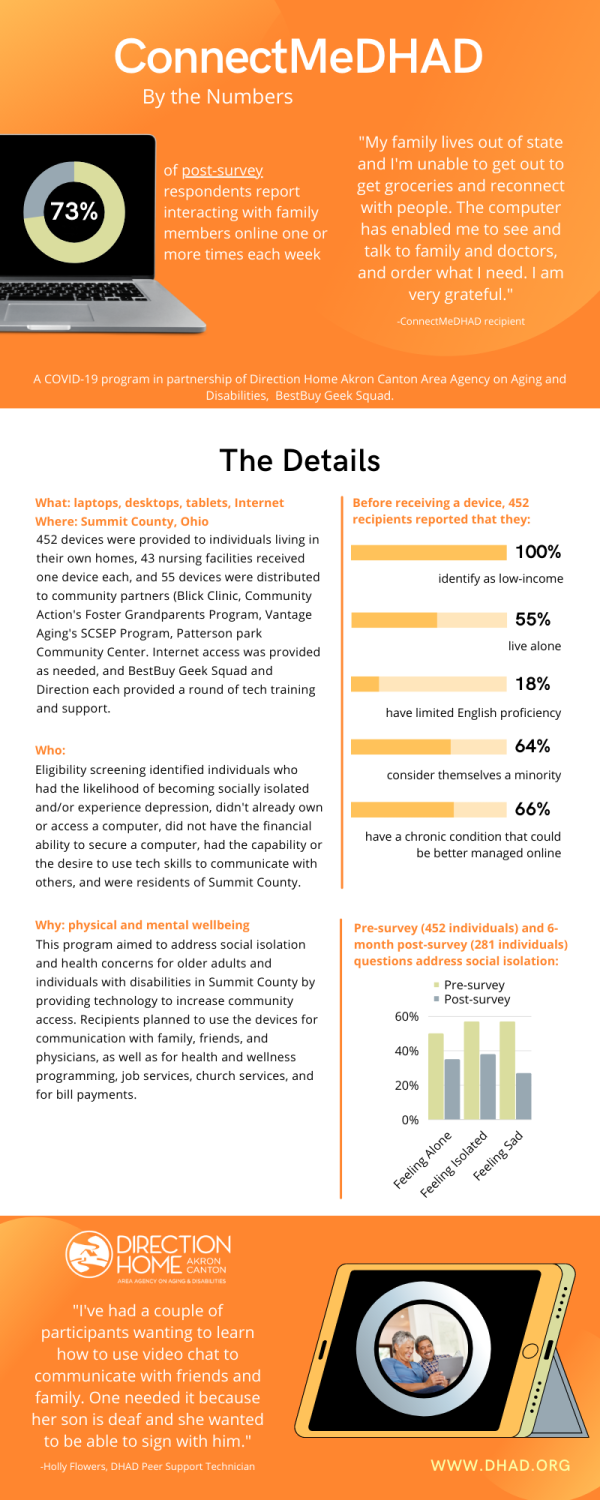
The ConnectMeDHAD program was introduced during the COVID-19 pandemic to address the technological and isolation needs of individuals living in Summit County, Ohio (thanks to COVID-19 CARES funding). Limited access to technology can create a barrier to healthcare, social services, and even socialization from family and friends. 550 devices (laptops, desktops, and tablets) were provided to the community, as well as internet access when needed. The program provided 452 devices to participants living in their own home, one device to each of the 43 nursing facilities in Summit County to increase accessibility for facility residents, and 55 devices to community partners, such as: Blick Clinic, Community Action’s Foster Grandparents program, Vantage Aging’s SCSEP program and Patterson Park Community Center.
6-month post-survey results from program provided interesting insights to device usage, connectivity, and technological trends. All individual recipients participated in the pre-survey (452) while 281 were able to respond to the post-survey 6 months after receiving their device. The 281 respondents reported heavy use for online banking, shopping, games, bill payments, videos, and social media, followed closely by communicating with family and friends. 66% of the 281 respondents reported using their devices frequently. For isolation and sadness, 100 reported feeling alone (35%), which is a staggering improvement from the pre-survey (15% improvement). This trend continued for the other two questions where 107 (38%) reported feeling isolated (19% improvement) and 75 (27% with a 30% improvement) reported feelings of sadness after receiving a device.
Another notable finding is gathering with friends or family. Before receiving a device, 65% of the individuals were able to interact with friends and family online one or more times each week. After the devices were distributed, this number jumped to 73% of the 281 respondents connecting with others online one or more times each week.
Regarding technological comfort levels-- confidence with online applications and payments as well as identifying online scams improved, while hesitancy using Zoom and Word remained high.
To address training and technology comfort, BestBuy Geek Squad provided initial setup assistance. Recipients demonstrated a need for additional help, so Direction Home applied for additional funding to provide one-on-one training for participants. The Peer Support Technician has now completed over 90 in-home visits, hosted 4 group trainings, and has created “Computer Clubs,” hopefully inspiring increased participation in the upcoming 12-month post-survey with more favorable results.
“We’ve heard story after story from participants of how these devices have been life savers. They have used technology to stay in touch with family and friends, keep entertained on lonely afternoons, learn a new skill, and meet essential needs like ordering groceries online. We have a lot of work ahead to make sure the skills are there to use this technology but our participants are willing and excited to learn.” -Holly Flowers, DHAD Peer Support Technician
Read a more in-depth summary of the 6-month survey results here.
